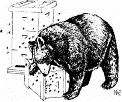Vertebrate Pest Conference Proceedings collection
Date of this Version
February 1982
Abstract
The utility and characteristics of the family of anticoagulant rodenticides are reviewed, including the new members difenacoum, bromadiolone and brodifacoum. General considerations are given in investigating the likelihood of nontarget poisoning with rodenticides. The literature dealing with secondary poisoning studies and concerns with the use of anticoagulant rodenticides is reviewed. The utility of laboratory toxicity data versus field-generated exposure data is compared. Considerations of secondary poisoning by anticoagulants are reviewed as regards parameters such as specific predator-prey systems, biotopes, rodenticide use patterns, and risk-benefit assessments. Finally, examples of appropriate field studies proposed to assess specific secondary poisoning risk situations associated with particular anticoagulant usage patterns are exemplified by reference to studies conducted by ICI and outside researchers with brodifacoum rodenticide bait formulations.

